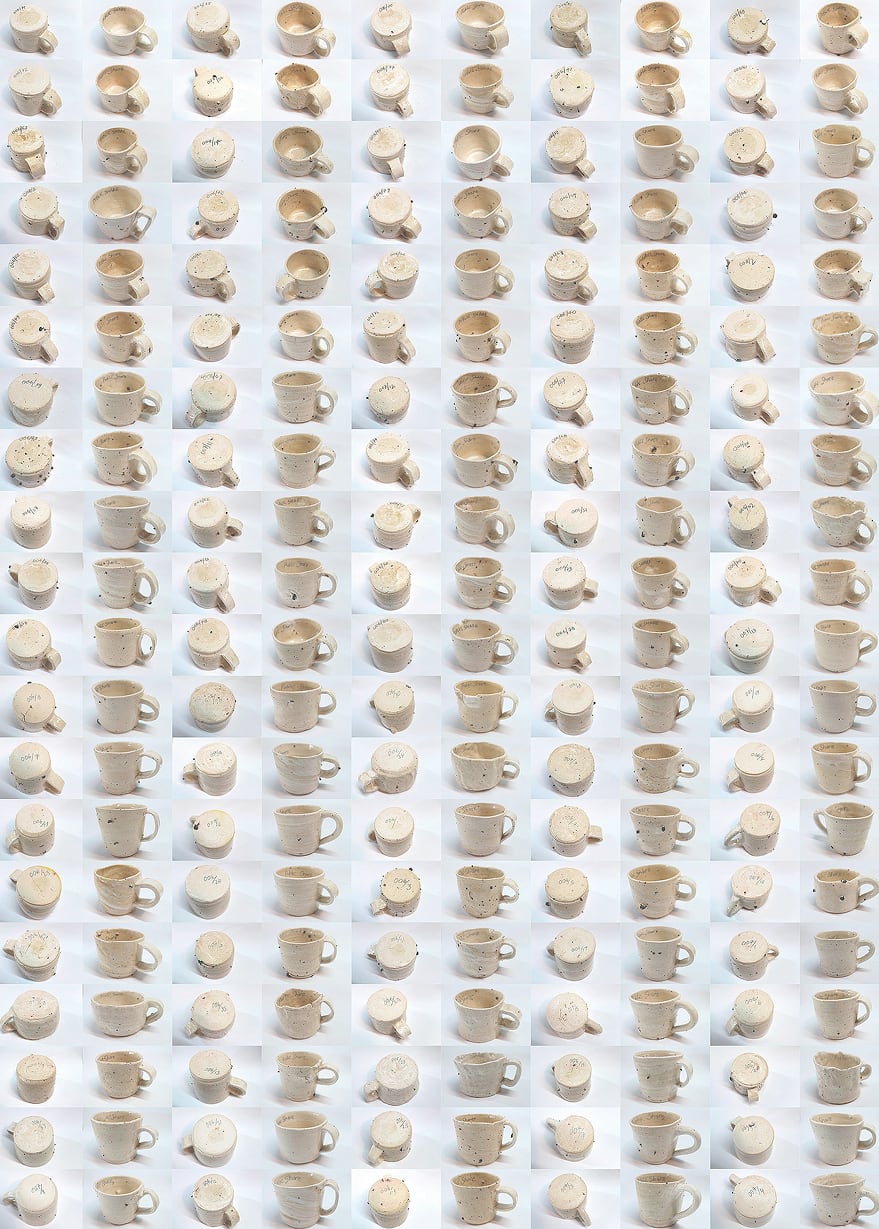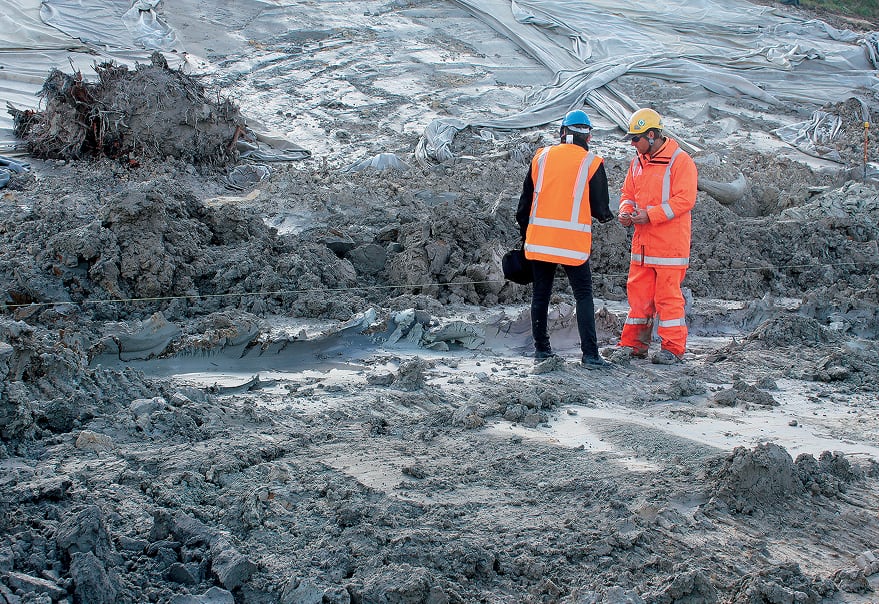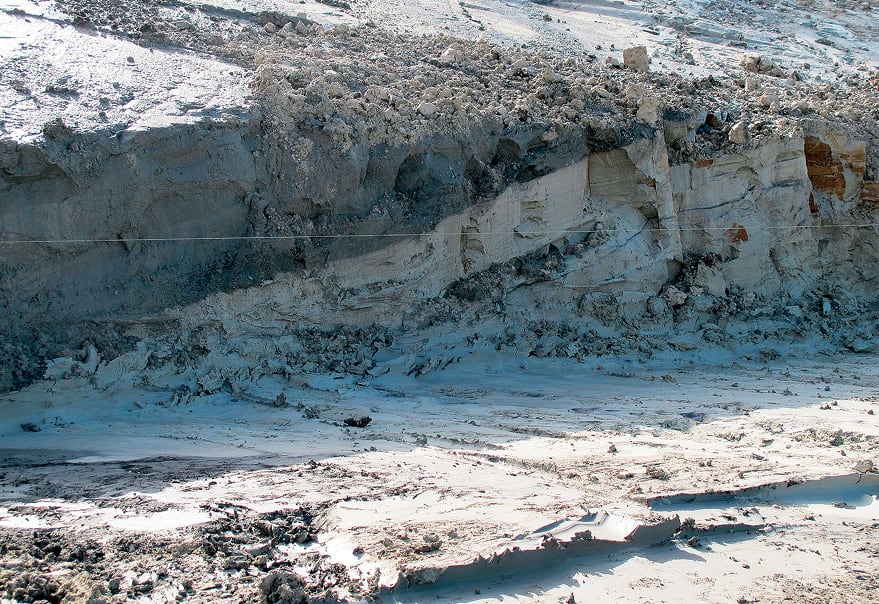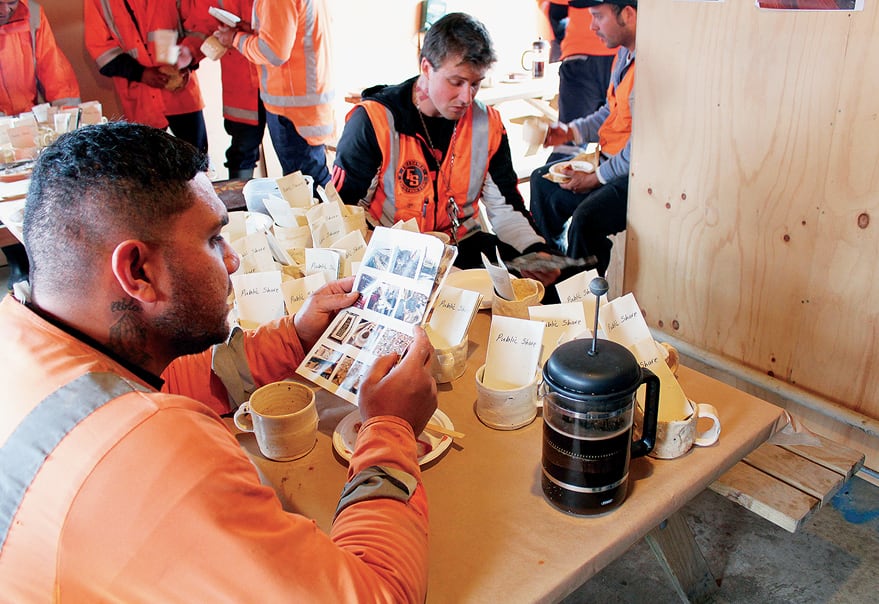 Public Share is a New Zealand–based collective of seven artists (Monique Redmond, Harriet Stockman, Kelsey Stankovich, Deborah Rundle, Mark Schroder, Joe Prisk and, until recently, Kirsten Dryburgh) founded in 2014. Their work involves nuanced conversations embedded in acts of making and sharing. With a keen interest in participatory happenings, Public Share’s work has occupied allotted break times in different contexts where they play the role of host. This usually includes an object (cup, mug, stirrer, plate) made by hand from clay to accompany some kind of beverage or meal.
It’s hard to find Public Share’s work unless you are privy to an arts symposium or festival. I enjoyed it twice last year during the ST PAUL St Curatorial Symposium and again at the Whau Arts Festival 2015. At the ST PAUL St event they provided hospitality during scheduled breaks throughout the day. I saw their work Carried Forward on the schedule and wasn’t too sure what to think. I was slightly reluctant, yet the work functioned differently to what I imagined. Participatory art practices require a degree of co-creation with their audience. There’s a sense that to engage you have to ‘do’ something. Public Share needed me to participate, and at 9am with a day of symposia to brace myself for, I didn’t feel like becoming an artwork. But the clay ‘mugs’ Public Share had on offer on this particular morning were beautiful! I wanted the glazed beige cup with brown speckles and large dark slightly sharp obtrusions, so I obliged in a tea. To my surprise they actually didn’t expect any more from their co-creators (aka audience) than to slow down, drink a tea and keep their cup. Their work consciously forced symposium participants to slow down as a means to reinstate formalised breaks and encouraging the discussion and networking that occurs in these spaces. Public Share utilised the space of given breaks within this environment to talk about those who don’t receive the same privileges. I didn’t get the sense there was anything political in this encounter with Public Share. And, actually, I assumed it entered into a very tired dialogue of social practice — with the likes of Rirkrit Tiravanija — of generating social interactions within isolated art spaces.
I encountered Public Share again, a month later, at the Whau Arts Festival, still ignorant of the depth of their practice. For this work, A Right Stirrer, they were removed from their usual allocation of fixed break times. Instead, they occupied an open shipping container for four days with tea constantly on offer, as well as gingernut biscuits and a clay stirrer emblazoned in gold with the collective’s logo. This participatory artwork was an endurance performance that required the artists to constantly engage in passing conversations. Through the change in format from temporary to permanent, they became a constant fixture among a diverse multi-day festival line up. Amongst an immense flurry of activity, they once again offered space for people to slow down and gather.
As I engaged in more conversation with Public Share, I came to learn that there was more than conviviality driving their practice. There are an unbelievable amount of co-workers in Public Share. Beyond the collective’s core members, their collaborators extend to the audience and symposium convenors, and most interestingly to employees of the large infrastructure construction company, Fulton Hogan.
Public Share is a New Zealand–based collective of seven artists (Monique Redmond, Harriet Stockman, Kelsey Stankovich, Deborah Rundle, Mark Schroder, Joe Prisk and, until recently, Kirsten Dryburgh) founded in 2014. Their work involves nuanced conversations embedded in acts of making and sharing. With a keen interest in participatory happenings, Public Share’s work has occupied allotted break times in different contexts where they play the role of host. This usually includes an object (cup, mug, stirrer, plate) made by hand from clay to accompany some kind of beverage or meal.
It’s hard to find Public Share’s work unless you are privy to an arts symposium or festival. I enjoyed it twice last year during the ST PAUL St Curatorial Symposium and again at the Whau Arts Festival 2015. At the ST PAUL St event they provided hospitality during scheduled breaks throughout the day. I saw their work Carried Forward on the schedule and wasn’t too sure what to think. I was slightly reluctant, yet the work functioned differently to what I imagined. Participatory art practices require a degree of co-creation with their audience. There’s a sense that to engage you have to ‘do’ something. Public Share needed me to participate, and at 9am with a day of symposia to brace myself for, I didn’t feel like becoming an artwork. But the clay ‘mugs’ Public Share had on offer on this particular morning were beautiful! I wanted the glazed beige cup with brown speckles and large dark slightly sharp obtrusions, so I obliged in a tea. To my surprise they actually didn’t expect any more from their co-creators (aka audience) than to slow down, drink a tea and keep their cup. Their work consciously forced symposium participants to slow down as a means to reinstate formalised breaks and encouraging the discussion and networking that occurs in these spaces. Public Share utilised the space of given breaks within this environment to talk about those who don’t receive the same privileges. I didn’t get the sense there was anything political in this encounter with Public Share. And, actually, I assumed it entered into a very tired dialogue of social practice — with the likes of Rirkrit Tiravanija — of generating social interactions within isolated art spaces.
I encountered Public Share again, a month later, at the Whau Arts Festival, still ignorant of the depth of their practice. For this work, A Right Stirrer, they were removed from their usual allocation of fixed break times. Instead, they occupied an open shipping container for four days with tea constantly on offer, as well as gingernut biscuits and a clay stirrer emblazoned in gold with the collective’s logo. This participatory artwork was an endurance performance that required the artists to constantly engage in passing conversations. Through the change in format from temporary to permanent, they became a constant fixture among a diverse multi-day festival line up. Amongst an immense flurry of activity, they once again offered space for people to slow down and gather.
As I engaged in more conversation with Public Share, I came to learn that there was more than conviviality driving their practice. There are an unbelievable amount of co-workers in Public Share. Beyond the collective’s core members, their collaborators extend to the audience and symposium convenors, and most interestingly to employees of the large infrastructure construction company, Fulton Hogan.

…the workplace ritual of the ‘break’ and the implied relations, social and political, that pausing for a 10-minute ‘cuppa’ brings. Our projects embrace the ‘everyday’ as a means through which to engage in making and sharing. Site, place and production are interrelated and culminate through a series of exchanges — discussion, negotiation, collection, testing, making, sharing — to form, in essence, a small revolt: a free offering and an invitation to stop work.3
Lana Lopesi is a writer, designer and social practitioner working out of Auckland, New Zealand.
1. The clay Public Share use to craft objects to date has been collected from two Auckland sites: the Fulton Hogan SH16 Northwestern Motorway Interchange site in Te Atatu Peninsula, and Well-Connected Alliance’s Alice motorway tunnel site at Waterview. This highlights an interest for the collective in land displacement and also creates a locality for the objects themselves.
2. David Hall, ‘Sensing Sovereignty: On What’s Real About Emergency’, in Jon Bywater et al. (eds), Reading Room: A journal of Art and Culture, Auckland Art Gallery Toi o Tāmaki, 2015. pp. 8–29.
3. Author’s email correspondence with Public Share, February 2016.
[^4]: David Hall, op. cit.

